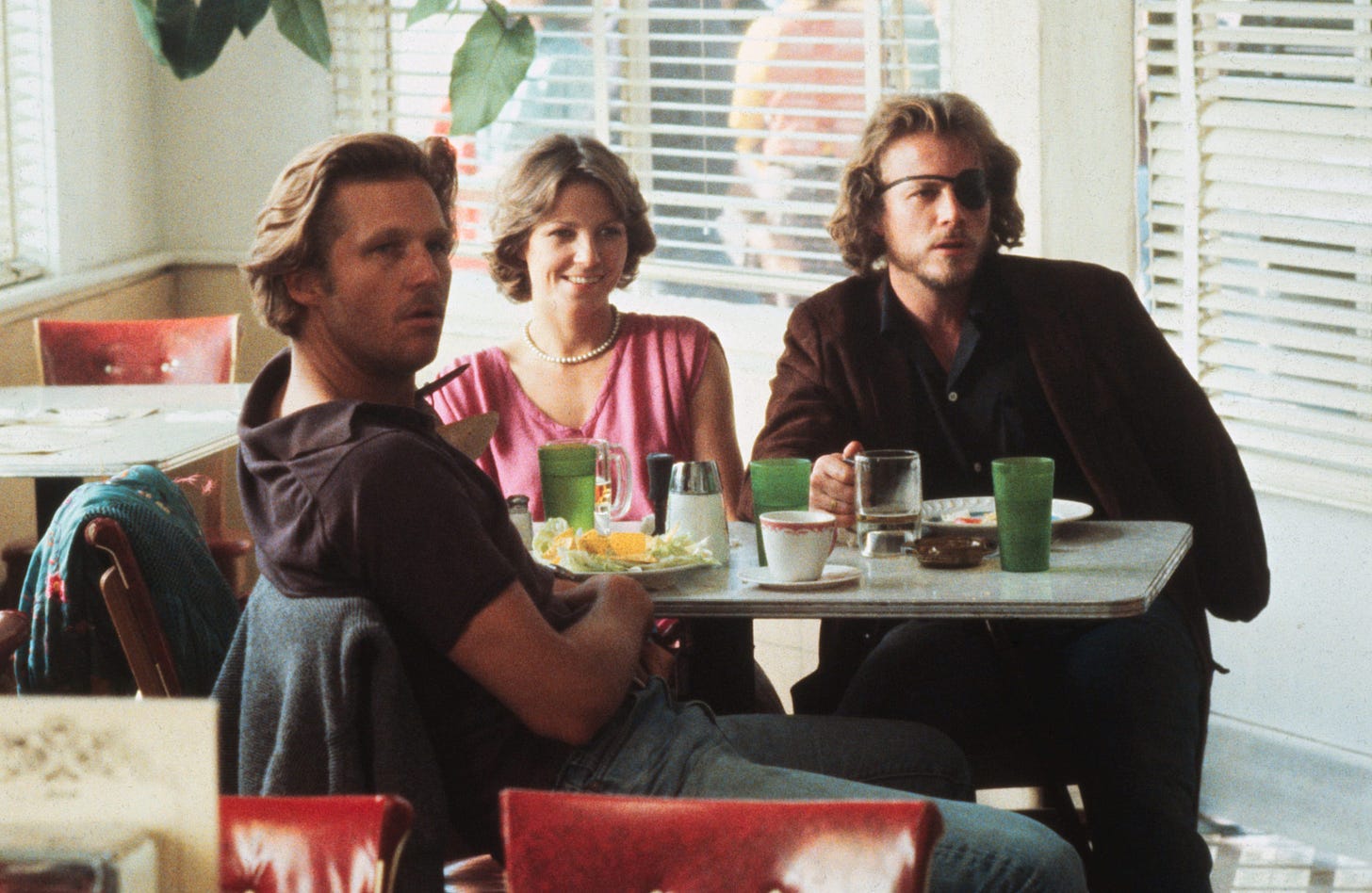The ’80s in 40: ‘Cutter’s Way’ (March 20, 1981)
Jeff Bridges and John Heard star in a haunting mystery about a dead cheerleader — and about what had happened to America in the years since the '60s drew to a close.
The ‘80s in 40 revisits the decade of the 1980s choosing four movies a year, one from each quarter. The entry covers the first three months of 1981
Stop me if you’ve heard this one before: Set in Southern California, this film stars Jeff Bridges as a layabout with no visible means of support who spends most of his waking hours under the influence. His character sat out Vietnam in college but his best friend is a Vietnam vet with a self-destructive streak. Together they investigate a mystery in which all signs seem to point toward a tycoon whose wealth and power have seemingly placed him above the law.
There’s no bowling in Cutter’s Way. And, really, there’s no mistaking it for Joel and Ethan Coen’s The Big Lebowski, which is wildly different in tone and style (and in just about every other respect, for that matter). But the Santa Barbara of Cutter’s Way and the Los Angeles of Lebowski share a lot of common ground, thematically if not geographically. They’re places where time has moved on from the ’60s but they’re filled with residents who haven’t, who struggle to find places for themselves in the crueler, more cynical world that’s risen from the ashes of the struggles of the ’60s. They’re places where, to quote the other Jeff Lebowski, “the bums lost.” But that doesn’t mean the bums are done fighting.
Bridges plays Richard Bone, whom we meet shortly after the latest in what would seem to be a string of hook-ups with bored women of means in hotel rooms. Introduced carefully grooming his mustache as he stands shirtless with his pants unbuttoned beneath his flattened abs, Bone looks the part of a gigolo and plays it, too. That doesn’t mean he’s any good at it, however, as evidenced by the look of disappointment on his lover’s face and her suggestion he might want to pick up some vitamin E. Bone leaves her with a pamphlet on some yachts, part of another hustle promoting a nearby marina where his longtime friend George (Arthur Rosenberg) works. But, swagger and all, Bone knows he’s lost a customer.
Soon he’ll have other worries, many of them tied to his friend Alex Cutter (John Heard), a Vietnam vet who lost an arm, leg, and eye in combat. Alex also seems to have lost any ability to censor his sardonic wit. Bone finds him in the middle of a late-night poker game on the verge of turning violent after Cutter starts riffing on racial epithets to the great displeasure of everyone around him, especially some Black men Cutter nearly provokes to violence. They back away when Bone reminds him of Cutter’s service. It won’t be the only time Cutter uses his past and his disability to get out of trouble, though he’ll find that trick has its limits.
Heard plays Cutter as a man perpetually in search of new ways of killing himself, only to step back from the ledge at the last moment (or at least make sure he’s around others he knows will pull him back). When Bone inadvertently gives Cutter a cause to fight for, however, he also dooms his friend to push himself further than ever before. Bone returns the drunken Cutter to the small home Cutter shares with his wife Maureen (Lisa Eichhorn) — and on some nights at least, with Bone, who seems to have no permanent place of his own and who has an unsettled history with Maureen. The next morning, he finds himself being questioned by the police, who’ve discovered Bone’s broken-down sports car, another ’60s product who’s seen better days, near the body of a cheerleader found stuffed in a garbage can.
They don’t seriously consider Bone a suspect, but Bone finds himself troubled by the encounter, a sentiment shared by Cutter and the cheerleader’s sister Valerie (Ann Dusenberry), whom the pair befriends. Bone didn’t kill the cheerleader, but who did? And why do all the signs keep pointing toward J.J. Cord (Stephen Elliot), a local business magnate powerful enough to grace the cover of the latest issue of Time?
Adapted from Newton Thornburg’s 1976 novel Cutter and Bone (the film’s original title), Cutter’s Way is a mystery in which the sleuthing takes is often secondary, if that. That might help explain some of the uncharitable reviews it received when it first opened in New York in early 1981 (where it might have died if not for a second wave of better reviews). Writing for the Hackensack Record, Jim Wright called it “the most muddle-headed movie so far this year.” “Why are Cutter and Bone such good buddies? Why does Maureen drink all the time, and why does she hang out with a loser like Cutter?” his review asks after accusing the film of raising “the wrong kinds of questions.”
Ultimately, however, Cutter’s Way is more interested in these questions than the question of who done it. That certainly wasn’t at the top of the minds of those making the film, which at one point had three possible endings. “We didn’t know either,” screenwriter Jeffrey Alan Fiskin told LA Weekly at the time, “but finally we figured out that whether this character was or was not the murderer, his actions would be more or less the same anyway, because he was so rich and powerful.”
That statement gets at the heart of a movie more interested in what the America of the 1980s was doing to the children of the ’60s, both those it sent away to war and those who’d turned inward and grown jaded as the decade’s promise slipped away. Bone may be a bum but he’s held onto his vanity. Perhaps watching what’s become of Cutter is reason enough for Maureen to drink all the time (and it’s not like her friends aren’t keeping pace). The Big Chill would arrive in theaters in a couple of years. Nobody’s dancing to The Temptations here.
“Cutter’s Way is one of the greatest American films of the 1980s and at the same time, it is the swan song of a whole cinematic genre,” Bertrand Tavernier says in an interview included on Fun City Editions’ (very good) Blu-ray of the film and it’s not hard to see what he means. This kind of grungy, downbeat, character-driven film wasn’t uncommon in the 1970s but was quickly going out of style in the 1980s and Cutter’s Way wouldn’t find a wider audience until it started turning up in theaters and in video stores. (That United Artists was still reeling from Heaven’s Gate, which hastened the end of this kind of filmmaking, didn’t help either.) But if it’s a film in a ’70s mode, it’s also very much about the 1980s.
“The premise of the book, I think, in one simple notion,” Fiskin says elsewhere in the LA Weekly interview, “is that the insanity of post-Vietnam America is such that only a madman could perceive it correctly. Or put another way: the premise is that paranoia is really the only viable lifestyle.” Heard’s performance embodies that sentiment, but it also suggests its limits. Cutter pursues noble ends, but in some respects he’s as scummy as those he pursues. The racist sentiments of his introductory scene may be a provocation for its own sake or it might just be, well, racism. (Not that that kind of provocation is great, either.) He hits Maureen and generally doesn’t care who else he hurts or how he hurts them. It’s a thrilling performance in part because Heard doesn’t care whether viewers like the character or not. Paranoia might be the only sane response to an insane situation, but who can live that way forever?
Ivan Passer serves as the film’s director. A veteran of the Czech New Wave, he directed one of the movement’s most revered films, Intimate Lighting, and co-wrote several others — including the classics Loves of a Blonde and The Firemen’s Ball — with their director, his friend Miloš Forman. When staying in Czechoslovakia became untenable, Passer and Forman fled to Hollywood together.
After directing One Flew Over the Cuckoo’s Nest in 1975, and winning a Best Director Oscar for his work, Forman became an in-demand director for the rest of his career. Passer’s profile never reached those heights, but he worked steadily. (Forman died in 2018, Passer in 2020. By coincidence, both released their final films in 2006.) Passer may have never been given the keys to a big-budget production like Ragtime or Amadeus, but maybe that’s apt. Maybe this world suited him better. Besides, that level of success might have kept him away from a misunderstood misfit like Cutter’s Way. History might be written by the winners, but someone has to tell the losers’ stories.
Next: Heaven’s Gate
Previous Entries in this Series:
9 to 5 (December 1980)
Urban Cowboy (June 1980)
Ordinary People (September 1980)
Little Darlings (March 1980)







It seems impossible that the Coens did not borrow liberally from strands of this film's DNA as they wove The Big Lebowski together, right down to the casting of Jeff Bridges. When I first watched this a few months ago, I couldn't help but note the many parallels. You note the very different tones, but both films are shaggy, hippie-inflected noir updates with other genres spiked in, especially the western. How about that crazy ending, with the doomed Cutter literally riding to Bone's rescue on a white horse? What a great, strange movie. If it had done better, it suggests a whole different arc for John Heard's career.
Can we all agree that "Cutter and Bone" is still a much better title?